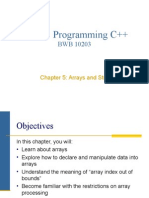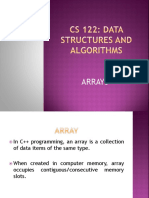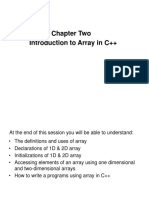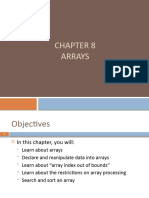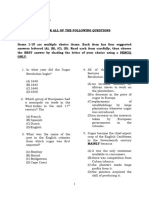0% found this document useful (0 votes)
209 views33 pagesChapter 7 - Introduction To Arrays
This document provides an introduction to arrays in C++ programming. It defines what an array is, how to declare and initialize arrays, and how to access individual elements of an array. It also discusses one-dimensional and two-dimensional arrays, passing arrays to functions, and initializing character arrays. Examples are provided to demonstrate array declarations, initialization, accessing elements, and passing arrays to functions. Exercises with solutions help reinforce key concepts about arrays.
Uploaded by
NUREEN AMIRA HASRUL NIZAMCopyright
© © All Rights Reserved
We take content rights seriously. If you suspect this is your content, claim it here.
Available Formats
Download as PPTX, PDF, TXT or read online on Scribd
0% found this document useful (0 votes)
209 views33 pagesChapter 7 - Introduction To Arrays
This document provides an introduction to arrays in C++ programming. It defines what an array is, how to declare and initialize arrays, and how to access individual elements of an array. It also discusses one-dimensional and two-dimensional arrays, passing arrays to functions, and initializing character arrays. Examples are provided to demonstrate array declarations, initialization, accessing elements, and passing arrays to functions. Exercises with solutions help reinforce key concepts about arrays.
Uploaded by
NUREEN AMIRA HASRUL NIZAMCopyright
© © All Rights Reserved
We take content rights seriously. If you suspect this is your content, claim it here.
Available Formats
Download as PPTX, PDF, TXT or read online on Scribd
/ 33



